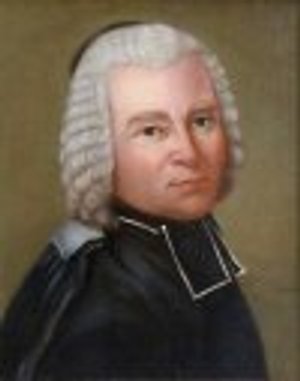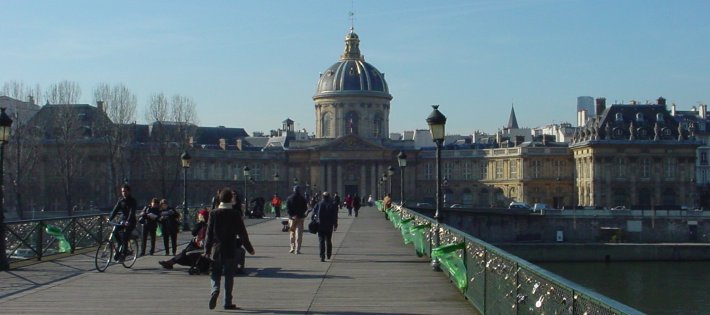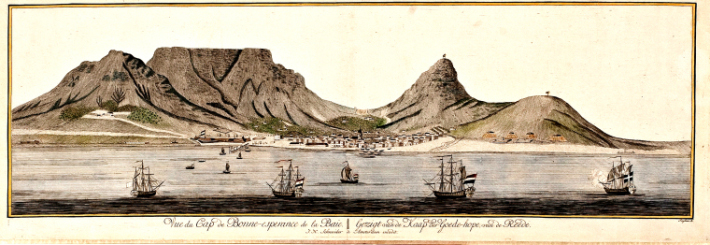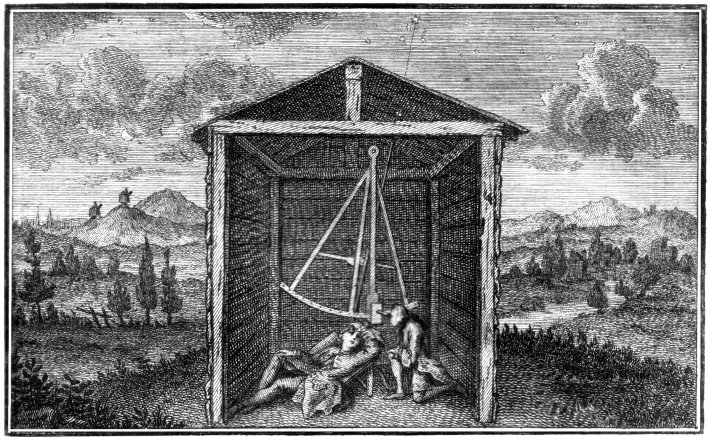Nicolas-Louis de la Caille
Astronomer and Geodesist
by I.S. Glass
Oxford University Press, Published December 2012, ISBN 978-0-19-966840-3
200 pages | 48 b/w illustrations | 234x156mm | Hardback
French edition, translated by James Lequeux: Nicolas-Louis de La Caille, Astronome et
géodésien
EDP Sciences
Published September 2013, ISBN978-2-7598-0999-8; Observatoire de Paris ISBN
978-2-901057-68-0
248 pages | illustrs: 22 colour and ~74 b/w | 240X160mm | Paperback
Both editions available from the author or Ms Thembela Matungwa (tw@saao.ac.za) for R400 in South Africa
|
La Caille © Observatoire de Paris (reduced resolution) Introduction: Abbé de La Caille
This is the first comprehensive biography of one of the greatest and most careful observational astronomers of all time, Nicolas-Louis de La Caille (1713-1762). Trained at the Paris Observatory under Cassini II, La Caille became Professor of Mathematics at the Mazarin College and built an observatory on its roof. Here La Caille began his lifelong programme of finding accurate postions for the bright stars, against which he could measure the paths of the Sun and planets. During his expedition to the Cape of Good Hope in the years 1751-53 he mapped the southern sky and gave many of the constellations the names by which they are still known. In conjunction with simultaneous measurements from Europe, he determined the distances of the planets Venus and Mars. In addition, while at the Cape, he contributed to geodesy by measuring the radius of the earth and paradoxically came to the conclusion that it is pear-shaped. The explanation of his error lay with local gravitational anomalies caused by mountains that deflected his plumb lines. La Caille interested himself in navigation and developed a practical procedure for making use of the Moon to determine longitudes at sea, known as the method of Lunars. He fed precise data to the leading applied mathematicians of the time, D'Alembert, Maupertuis and Clairaut. This information was critical to the development of the theory of planetary perturbations. La Caille was a firm believer in Newton's theory of universal gravitation, for which he was an able propagandist. Apart from his astronomical and geodetic work, while at the Cape La Caille made extensive notes of conditions among the colonists and slaves. His remarks constitute perhaps the most reliable commentary on conditions at the time. |
|
CONTENTS
Chapter 1: Early Life Birth of La Caille, education for priesthood following father's wish, narrowly escapes poverty, refuses ordination, studies astronomy at Paris Observatory, surveys Paris meridian, becomes professor of Mathematics at Collège Mazarin, builds observatory, member of Royal Academy of Sciences, teacher and textbook writer, believes other solar systems may be inhabited, strong advocate of Newtonianism, precise observer of stars, planets, eclipses and comets, takes account of mutual interactions of solar system bodies, plans visit to southern hemisphere.
Building of the Collège Mazarin, now the Institut de France Chapter 2: The Cape Sails for Cape with the hydrographer d'Après de Mannevillette, developes interest in navigation, friendship with Maraldi, meets and befriends Governor Tulbagh, rents part of house in Strand Street from Jan Lourens Bestbier, builds observatory on foreshore, his instruments, makes first telescopic survey of the sky, his catalogue, the Coelum Australe Stelliferum, his new constellations, rubbishes Halley's Robur Carolinum, lists nebulous objects, determines position of Cape, studies atmospheric refraction, observes Sun, Moon and planets.
Cape Town around the time of La Caille's visit (Library of Parliament) Chapter 3: The Shape of the Earth Earth's radius derived by combining astronomical latitude observations at two points on a meridian with geodetic surveying of the intervening distance. La Caille proposes a measurement to Governor, reconnoitres the Swartland, makes expedition by ox-wagon with Bestbier and slaves, experiences hospitality at various farms, triangulates from summits of Kapokberg and Kasteelberg, establishes northern station at Piketberg, makes meticulous measurement of Swartland base, comes to surprising conclusion that the earth is pear-shaped, re-checks his measurements and finds no fault with them.
La Caille (lying) and Cassini de Thury making a latitude measurement during the survey of the Paris Meridian. La Caille used the same instrument in the Swartland of the Cape (from Cassini de Thury, 1740) Chapter 4: Notes about the Cape Remarks about the Cape from his Journal Historique, Table Mountain, inland travels, botany and zoology, anthropology, his Remarks on weather, food, farming, animals, hospitality, administration, slaves and prostitution, the Khoina (native peoples), denigrates Kolbe (earlier writer on the Cape). Mentzel (later writer) criticises La Caille in turn.

Title page of La Caille's Journal Historique in which he described his visit to the Cape Chapter 5: Later years Returns to France via Mauritius and Réunion, overwhelming reception at the Academy of Sciences, his map of the Cape, his behaviour and activities in later life, controversies with Euler and Le Monnier, his students Lavoisier, Benoit and Lalande, friendship with Clairaut, Bouguer, La Condamine and Turgot, later studies of Lunars, solar system objects, his Fundamental Astronomy and Solar Tables, correspondence with Tobias Mayer, return and naming of Comet Halley, Transit of Venus (1761), his swan song, death, burial under the Mazarin Chapel, his effects, memorial, summing up.
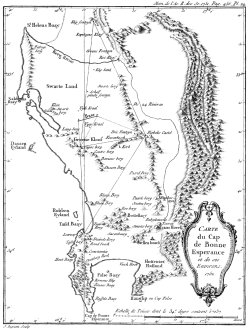
La Caille's map of the Cape (from his 1751 publication in the Memoirs of the Royal Academy of Sciences) Chapter 6: Paradox resolved Cavendish experiment, visit of Everest to La Caille's sites in 1820, detective work, new large-scale expedition to Swartland and re-measurement by Maclear in 1840s, new baseline, comparison with La Caille's results, conclusion that his work was accurate but affected by mountain masses at his northern and southern stations.
Maclear's camp at Piketberg ca 1842 (from Maclear, 1866). La Caille's northern terminal sites were extremely difficult to locate. |
|
Opinions
"Glass brings brilliantly to life the indefatigable 18th-century man De La Caille, who in his two-year sojourn at the Cape of Good Hope named nore constellations than any other recorded astronomer. Vividly portrayed are his triumphs and failures, his friends and detractors" Owen Gingerich, Harvard-Smithsonian Centre for Astrophysics "La Caille was a leading figure among eighteenth-century observational astronomers, and his observations at the Cape of Good Hope are discussed in this eloquent and informed narrative. While his period at the Cape forms only a part of his life and work, it is no doubt the most striking in his biography." Peter Harman, Department of History, Lancaster University "Nicolas-Louis De La Caille was an engaging and significant and significant figure in the fascinating world of eighteenth-century science. No armchair philosopher, La Caille travelled far in pursuit of scientific truths. Ian Glass's book on La Caille will appeal to astronomers and geodesists concerned with the development of their disciplines, historians of science, and readers drawn to adventurous characters." Robert Smith, Department of History and Classics, University of Alberta. "Nicolas-Louis de La Caille was one of the greatest observational astronomers of all times, and can still be considered as a model for today's scientists. In this book, Ian Glass emphasizes his qualities in a vivid way, while describing the enormous amount of work he was able to accomplish during his short life. I liked the book so much that I decided to translate it into French." James Lequeux, Paris Observatory "This is an excellent and detailed book, not only dealing with a great astronomer, but exploring the less-well-known world of 18th-Century French research astronomy. It is lucidly written and thoroughly documented." Allan Chapman, The Observatory. "...this is a tightly-written book about the life and contributions of a great scientist who was active during the heyday of the Enlightenment. It is also an adventure story about a man who journeyed to another hemisphere in order to further his work. The book should appeal to astronomers, (both amateur and professional), earth scientists, map lovers (both terrestrial and celestial) and anyone interested in the history of science. I wholeheartedly recomment it," Nic Kamas, Journal of International Map Collectors Society "... well-written, nicely-researched, copiously illustrated and very modestly priced ,,," Wayne Orchiston, Journal of Astronomical History and Heritage "A book previously missing on pioneering work in the field of geodetic astronomy has now been supplied by Ian Stewart Glass...extremely well researched, drawing on numerous manuscripts and printed sources that are listed in a remarkable bibliography. Students will find interesting discussions of Lacaille's training and his model of scientific practice. Experienced researchers will not fail to appreciate the scholarly care with which Glass has examined Lacaille's published and unpublished works." Suzanne Débarbat, Journal for the History of Astronomy "This book will be of particular interest to people who know, or are visiting the Cape ... It is also well illustrated with pictures, maps and diagrams ... I would recommend this book to anyone interested in eighteenth century astronomy or who is planning a visit to Cape Town," Mark Hearn, Society for the History of Astronomy Bulletin. |
